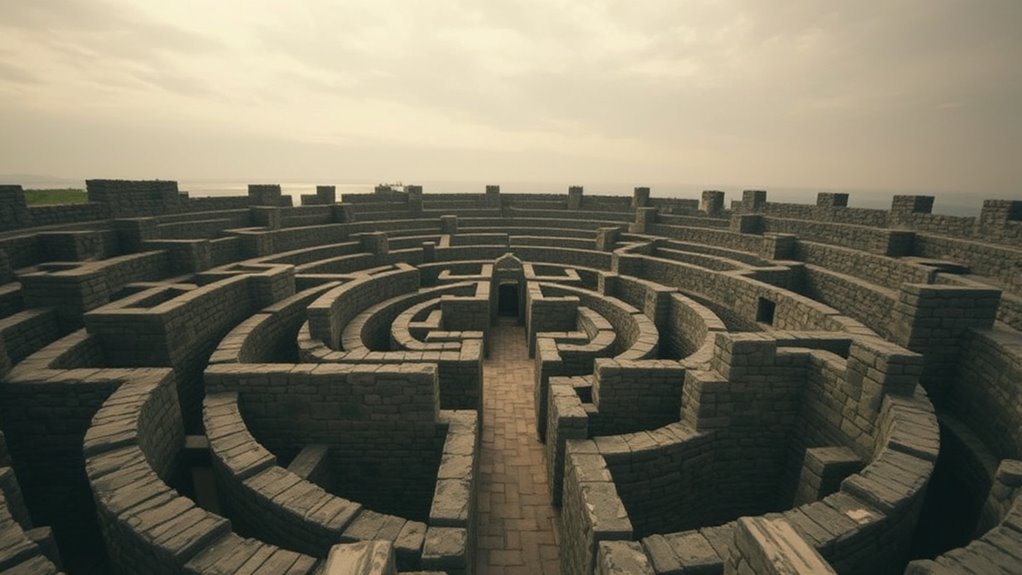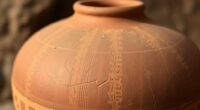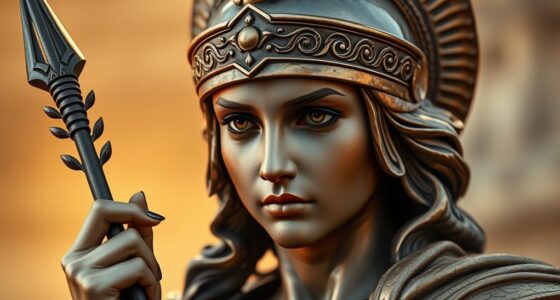The Minotaur’s labyrinth is both an impressive engineering feat and a profound moral symbol. Its winding corridors and dead ends showcase ancient Greek mastery in architecture and design, meant to confound and imprison the creature. At the same time, it reflects deeper themes of chaos, human nature, and moral challenges—serving as a metaphor for life’s complexities and internal struggles. If you keep exploring, you’ll uncover how this ancient structure embodies more than just physical ingenuity.
Key Takeaways
- The labyrinth exemplifies ancient engineering prowess with its complex, winding passages designed to confound and trap, showcasing technical skill.
- Its intricate design symbolizes chaos, order, and moral lessons, serving as a powerful metaphor for human nature and the subconscious.
- The structure functions both as a physical barrier and a moral allegory, warning against hubris and chaos beneath civilization.
- The labyrinth reflects deeper cultural themes, embodying primal fears, moral dilemmas, and the journey toward self-awareness.
- As an enduring symbol, it combines practical engineering with profound symbolic meaning, inspiring reflection on human struggles and morality.

Have you ever wondered what lies at the heart of Greek mythology’s most infamous maze? The Minotaur’s Labyrinth isn’t just a baffling maze of winding corridors; it’s a powerful symbol that embodies deeper themes rooted in mythical symbolism and architectural complexity. When you consider this labyrinth, you’re looking at more than stone and mortar—you’re examining a structure designed to reflect chaos, order, and the darker aspects of human nature. Its architectural complexity is legendary, with twisting passages and dead ends that seem to trap not only its inhabitants but also the minds of those who study it. This intricate design wasn’t just a feat of engineering; it was a deliberate creation meant to confound and imprison. The labyrinth’s winding pathways symbolize the convoluted nature of life and the subconscious, drawing you into a space where clarity is elusive, and every turn might lead to salvation or destruction. Its mythical symbolism extends beyond its physical form, representing the primal fears and moral dilemmas faced by ancient Greeks. The story of Theseus navigating the labyrinth to slay the beast underscores this tension between chaos and order—highlighting how human ingenuity and courage can confront the darkest parts of the psyche. As you analyze its structure, you realize that the labyrinth is more than a prison; it’s a reflection of the complexities within ourselves and society. The architectural complexity of the maze was no accident; it was a deliberate design that served as a moral metaphor, warning of the dangers of hubris and the chaos that lies beneath civilization’s veneer. The Greeks understood that such a structure could serve as a physical and symbolic barrier—one that challenged heroes and everyday individuals to confront their fears and moral failings. The intricacies of the maze also symbolize the journey inward, urging you to traverse the tangled pathways of morality, instinct, and wisdom. In essence, the Minotaur’s Labyrinth stands as both an engineering marvel and a profound moral metaphor—an enduring symbol of the struggle to impose order on chaos, to face primal fears, and to find meaning amid confusion. Its mythic symbolism invites you to reflect on the complexities of human nature and the enduring power of stories that challenge us to confront our deepest instincts. Additionally, the architectural complexity of the maze exemplifies how ancient engineering was intertwined with symbolic meaning, making it a timeless metaphor for human struggles.
Frequently Asked Questions
What Is the Historical Origin of the Minotaur Myth?
You might wonder about the Minotaur myth’s origins, which trace back to Ancient Crete during the Minoan civilization. The story likely symbolizes the complex relationship between humans and nature or the power struggles within ancient society. The myth reflects how myths often embody societal fears, beliefs, and values, serving as allegories for real historical or cultural conflicts faced by the Minoans.
How Does the Labyrinth Symbolize Human Psychological Struggles?
You see the labyrinth as a symbol of your mind maze, where complex thoughts and hidden fears reside. It reflects emotional entrapment, trapping you in cycles of doubt or anxiety. Steering through the maze requires inner strength, much like confronting your psychological struggles. It’s a reminder that understanding yourself involves exploring this intricate mental landscape, facing the fears and doubts that keep you trapped, and finding your way out toward clarity and peace.
Are There Modern Engineering Equivalents to Ancient Labyrinths?
You might see modern engineering equivalents to ancient labyrinths in maze design and security systems. These structures challenge your navigation skills, much like old labyrinths did, but now they serve practical purposes like protecting valuables or controlling access. You’re actively engaging with complex pathways, whether in physical mazes or digital security measures, reflecting a continued fascination with intricate design that tests and safeguards your journey through space and information.
What Moral Lessons Does the Minotaur Myth Convey?
You see, the Minotaur myth teaches about moral ambiguity and heroic sacrifice. It challenges you to contemplate how sometimes, tough choices involve risking or sacrificing oneself for a greater good. The hero’s journey highlights moral complexities, reminding you that actions aren’t always clearly right or wrong. This story encourages reflection on the costs of heroism and the blurred lines between good and evil, urging you to think critically about moral decisions.
How Has the Minotaur Myth Influenced Contemporary Literature and Art?
You see how the Minotaur myth influences contemporary literature and art through powerful mythical symbolism. Artists and writers reinterpret the creature’s dual nature, exploring themes of inner conflict and monstrosity. These artistic reinterpretations often challenge viewers to confront their own fears and moral dilemmas, keeping the myth alive. By doing so, you can appreciate how this ancient story continues to inspire new, thought-provoking works across diverse mediums today.
Conclusion
So, next time you marvel at a complex maze or a daring engineering feat, remember it might just be a modern Minotaur’s labyrinth—designed to trap or test us. Maybe our greatest creations are less about progress and more about proving we can build walls around our moral dilemmas. After all, who needs a beast when we willingly walk into our own labyrinths, all in the name of progress? Perhaps the real monster is inside us.









